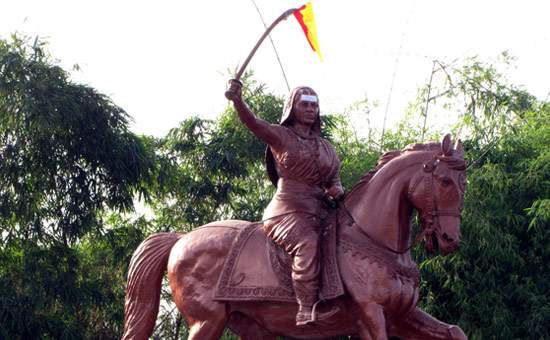The Kittur Revolt of 1824 marks one of the earliest woman-led anti-colonial struggles in India, spearheaded by Rani Chennamma against British forces attempting to invade the princely state of Karnataka.
Background
- Rani Chennamma: Born on October 23, 1778, in Kagati, Karnataka, she married Raja Mallasarja of Kittur at a young age.
- Succession Crisis: After her husband’s death in 1816, a succession crisis arose when the British East India Company refused to recognize Shivalingappa, the adopted heir, under the ‘doctrine of lapse’.
The Revolt
- Initial Conflict: In October 1824, British forces, led by John Thackery, attacked Kittur Fort.
- Rani Chennamma’s Resistance: Leading the Kittur army, she retaliated fiercely, resulting in Thackery’s death and a temporary victory.
- British Conquest: Despite initial success, the British captured Kittur Fort on December 3, 1824, leading to Rani Chennamma’s imprisonment.
- Legacy: Rani Chennamma’s bravery and commitment to protecting her kingdom remain an integral part of Karnataka’s political consciousness.
Historical Perspectives
- Imperial Records vs. Folklore: Discrepancies exist between imperial records and folk songs (lavanis) regarding Rani Chennamma’s role and bravery.
- Post-Colonial Perception: Rani Chennamma’s leadership challenges traditional gender roles, emphasizing the importance of women’s strategic abilities and administrative skills.
Commemoration and Contemporary Relevance
- Naanoo Rani Chennamma Campaign: Organized by various social groups to commemorate 200 years of Rani Chennamma’s rebellion, emphasizing women’s rights and empowerment.
- Political Significance: The campaign advocates for equal rights and representation for women in politics and society, aiming to mobilize women against oppression and inequality.
- Modern-Day Challenges: Issues such as quality education and poverty eradication are highlighted as crucial for women’s empowerment and societal progress.
Multiple Choice Questions (MCQs):
- What was the cause of the Kittur Revolt of 1824?
- A) Economic crisis in Karnataka
- B) Succession dispute following Raja Mallasarja’s death
- C) Religious tensions with the British East India Company
- D) Cultural suppression by the British forces
- Answer: B) Succession dispute following Raja Mallasarja’s death
- Who led the British forces during the initial attack on Kittur Fort in 1824?
- A) Rani Chennamma
- B) John Thackery
- C) Shivalingappa
- D) Sangoli Rayanna
- Answer: B) John Thackery
- What was the outcome of the Kittur Revolt for Rani Chennamma?
- A) Permanent victory against the British
- B) Capture and imprisonment by the British
- C) Exile to a neighboring state
- D) Establishment of a new kingdom in Kittur
- Answer: B) Capture and imprisonment by the British
- How do imperial records differ from folklore regarding Rani Chennamma’s role?
- A) Imperial records praise her leadership, while folklore depicts her negatively.
- B) Folklore exaggerates her accomplishments, while imperial records downplay her role.
- C) Both sources provide consistent narratives about Rani Chennamma’s bravery.
- D) Imperial records ignore her contributions, while folklore glorifies her as a hero.
- Answer: D) Imperial records ignore her contributions, while folklore glorifies her as a hero.
